MA Eco-Social Design: Project 2 by Eliza Zimmermann, Emilia Bodenmüller, Juliana Lopes Sauaia | SS 2021
Supersensi. Musica del Sottobosco
Discover an interactive music station co-designed with forest kindergartners for self-expression and sensorial exploration through materials, sounds, and rhythms.
Supersensi is an educational initiative that aims to co-design interactive spaces for children to practice self-expression through the arts. Fostering sensorial exploration from an early age, it encourages kids to discover their personalities and their surroundings in a fun and creative way.
In partnership with Sottobosco, a forest kindergarten in Mezzomonte (Trentino), a music station in the woods was created with and for kids to explore sounds and rhythms. The seven kindergartners, Fabio, one of the parents, and Sofia, the forest educator, were actively involved in the decision-making processes and also participated in building instruments.
The music station counts with a wooden xylophone tuned on the C pentatonic scale, a shamanic drum, bamboo, metal, and clay chimes, nutshell shakers and a variety of playing sticks. The materials were carefully chosen focusing on sustainability and local availability, while ensuring quality and diversity of sounds.
Apart from the instruments, one artifact was designed to stimulate the kids’ own active exploration. The Supersenso is a playful wooden cone that can be used in various ways to sharpen the senses. Used on the ears, it amplifies or reduces the sounds of the environment; used on the eyes, it helps focus on a specific spot in the surrounding area.
The project stimulates emotional development by inviting visitors to investigate the music of nature and create their own. By complementing the physicality of outdoor-based activities, Supersensi helps enlarge the educational portfolio of Sottobosco, stimulating the growth of the kindergarten and allowing more families to benefit from the richness of forest education. Strengthening and promoting this initiative can also potentially drive change in the local public education sector, creating a fertile environment for similar initiatives to flourish.
text
Background
Sottobosco is a forest kindergarten operating since September 2020. It is a community-led initiative supported by the families of the 7 kindergartners and by Elisabetta, the owner of the organic farm (La Fonte) where Sottobosco’s activities take place. Besides enjoying the benefits of nature-based education, the kids also have the opportunity to experience the farm's daily life up close.
According to the principles of forest pedagogy, kids can benefit greatly from being immersed in nature, learning through research, and facing risk. Autonomy being a core value, every morning the kids decide together what they will do throughout the day. Regardless of the weather conditions, they play freely outside with little intervention from Sofia. High importance is also given to the so-called educating community, where all adults are accountable for the development of the children. Therefore, involved families share responsibilities of the kindergarten and the farm.
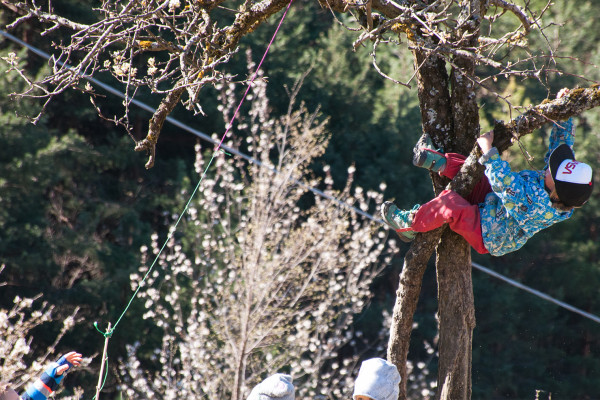
Free play and risk facing as principles of forest pedagogy.
"Lunedì azzurro è il primo.
Martedì rosso rubino
Come il sole del mattino,
mercoledì giallo giallino.
Giovedì è un po’ marrone.
Venerdì verde verdone,
Poi arriva il sabato blu come il mare.
Domenica è oro, si può riposare/giocare."- Nursery rhyme that opens Sottobosco’s morning circle
Initial challenges
Such principles worked both as guidelines and as requirements throughout our project development. Travel restrictions imposed by the COVID regulations also limited our initial research process, since for a while we were not able to visit the kindergarten. We started getting to know the partners and their expectations and mapping opportunities through online meetings. Pictures and videos sent by the Fabio (one of the parents) and Sofia were helpful to make sense of the place and of the kindergarten’s routine. We also took the time to interview specialists in co-design with children (Seçil Uğur and Johanna Mihevic) and live structures (Aart van Bezooijen).
Opportunities
Once the travel restrictions were relaxed, we carried out a participatory ethnography on our first visit. This allowed a more accurate brainstorming of possible strategies to support Sottobosco, focusing on topics such as infrastructural development, inclusivity, financial sustainability, and public visibility. After the project team and the partners had had the chance to freely vote on their favorite ideas, we prioritized the most voted three: a place to observe and interact with nature, a place to engage with arts, or workshop activities to promote forest education
We aimed for a design process as collaborative as possible, involving the kids, Sofia, Elisabetta, and the families in the key decisions and their implementation. At this point, we understood that our intention of involving the kids in every step of the decision-making process had been idealized. They could (and should) be part of it but bringing three different ideas to them wouldn’t be productive.
We identified greater potential in the forest atelier idea. Not only because there was a (so far underutilized) opportunity to approach art in the kindergarten’s routine, but also because many parents are engaged with design, art, and music. Amongst all art possibilities, we chose to explore visual arts and music. We reached out to Max Castlunger, a South Tyrolean musician and instrument maker that also worked connecting kids to music.
Participatory research
Avoiding guided activities and the use of technology was a great challenge when planning our research process with the kids. Later, we understood that the pedagogy welcomes organized activities, as long as the kids are free to decide whether to get involved (or not) in them. We planned two themed days and designed specific artifacts for each of them. For music, we proposed mapping the sounds of nature using a colorful Supersenso, a cone created to amplify the sounds of the environment. As soon as a sound would be found, a flag made out of branches and paper ribbons should be used to mark the spot. Many sounds were also recorded using a professional microphone. Later, we built DIY instruments (shakers, bamboo xylophone, elastic band harp) together with the kids with a mix of local, recycled, and external materials. For visual arts, we proposed mapping shapes, colors, and textures of nature and collecting them in a “magic jar”. Together with the kids, we then prepared natural paint (using beetroot, curcuma, paprika, charcoal, and chalk) and invited them to paint or create collages using brushes made out of natural sticks and glue made out of flour and water.
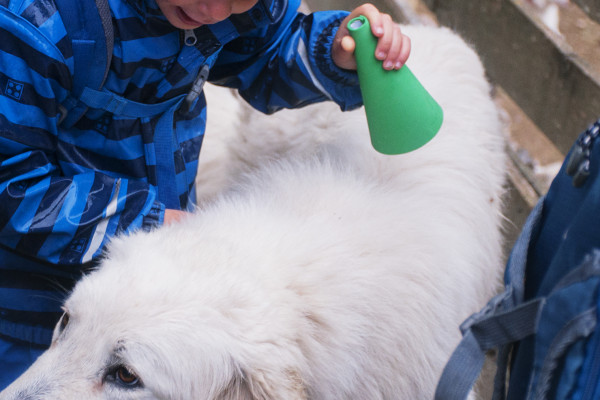
Exploration of the sounds of the farm using the first version of the Supersenso.
The experience was amazing and both us and the kids had a lot of fun. However, not having had time to test everything beforehand, we came across some surprises and learnings: some of the instruments didn’t sound so well, others didn’t look so good or weren’t so easy to make as expected. Our previous expectations had to be revisited as well. The painting and collage session, for example, pivoted towards a color mix and potion preparation workshop. The young age of the children (between 3 and 5 years old) and the language barrier (communicating in Italian) were also constraints we had to deal with.
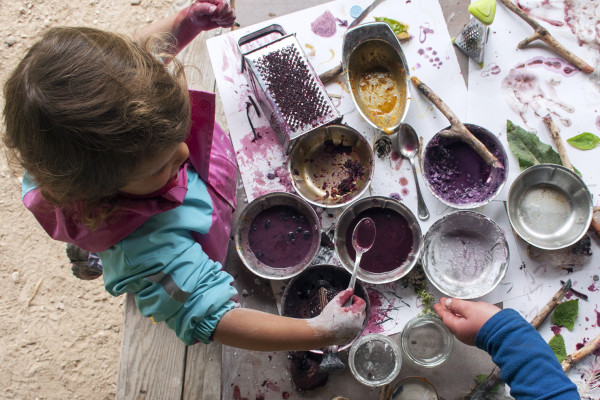
Natural watercolor session pivoting towards fun color mixing activity.
Noticing that the kids already took the initiative to draw and paint on their own, we identified a forest music station to be a greater contribution to the diversification of the infrastructure of Sottobosco. Given the musical skills of many parents, the station could also become a space for them to interact with the kids after the kindergarten activities, one of the identified needs during the opportunity mapping.
First designs
We reconnected with Max to visit his atelier and look for inspiration about instruments that we could make ourselves using natural materials. We understood that material diversity and musical theory play an essential role in constructing quality instruments with varied sounds. A second specialist in children’s pedagogy and former secretary of education (Lena Marin) was interviewed to further understand how such young kids perceive sounds and music.
The first designs of our music station considered a variety of instruments and their incorporation into the surroundings. The possibilities were three: a cozy wooden bench in a ribbon-like format with built-in instruments, inviting visitors to play together; an underground pipeline that serves as a communication tool and as a frame for the instruments; and a circular seating area with built-in instruments and a spider-web-like net for relaxation and contemplation of the music and nature’s sounds.
Considering the project timeline, the complexity of the seating areas invalidated options 1 and 3. As for the communication pipeline, its material requirements did not comply with the preferences of Sofia and Elisabetta. Our next proposal was a large-scale wooden Supersenso that could be used not only as a shelter for visitors and weather-sensitive instruments but also as a playful structure and acoustic shell. We sought the help of an architect (Ági Polyák) in planning the structure.
The next two visits to Sottobosco were focused on building rapport with the partners and the kids and on finding the best location for the music station. We helped Elisabetta, Sofia and the kids to build their own vegetable and fruit garden and went on a farm tour guided by Elisabetta. The tour clarified the boundaries of the farm and resulted in a map of La Fonte and the spaces of the kindergarten, later used at a treasure hunt during the Rural Commons Festival. We also left the first prototype of a pistachio shaker with the kids as a cultural probe. Videos sent by Sofia showed us the diverse and unexpected ways the kids played with it.
Calculating the necessary material, it became clear that the budget provided by unibz (200€) was barely enough to cover the costs of the instruments. The partners’ budget was also not available for a structure such as the large Supersenso. Elisabetta showed interest in gathering funds for its construction, yet that remains a future possibility.
Implementation
"Ecco il sol, spunta già.
Fa il suo girotondo.
E riempie il mondo.
Di calore e di bontà."- Nursery rhyme from Sottobosco that salutes the sun
In a second visit to Max’s music atelier, we learned how to tune the keys of the xylophone and the metal tubes of the windchimes. We also took measurements of the bar chimes and borrowed professional literature on instrument building. After purchasing all of the necessary material, we had a week-long preparation at the unibz metal, wood, and CNC workshops.
In an 8-day immersion at La Fonte, we finished building the instruments: a wooden xylophone, a shamanic drum, two wind chimes (aluminum and bamboo), two bar chimes (aluminum and bamboo), and three nut shakers (pistachio and walnut shells). We also built nine wooden Supersensi and various playing sticks of different materials (wool, rubber, wood, and nuts). We used only natural fibers (and glue) to assemble the instruments and treated all of the wood that would be exposed to the weather. Throughout the week, the kids interacted with the semi-finished instruments, which gave us valuable hints on durability and playfulness. The kids also participated in the building process through activities such as modeling clay for a third bar chime, felting sheep wool into balls, and tying the walnut shells together into a shaker. On the last day, we inaugurated the music station together with the kids.
To meet our deadlines, we tried baking the clay pendants in the metal oven from unibz, only to learn we should never have done that. Still, they were good enough for the last activity with the kids, where we built the clay bar chime and installed it in the music station. As the closing event, we had a beautiful spontaneous performance of the Banda della Cacca - the kids’ band formed even before the start of the project.
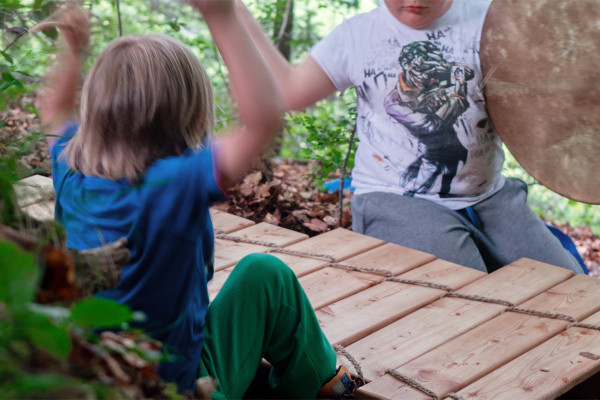
Spontaneous rock concert at the music station.
Future steps and potentials
Future steps include supporting Sofia to make the most out of Sottobosco’s music station, connecting her to Max and his wife, Cristina, who also works with kids and music. We’ll also offer continuous support to the partners, advising on the maintenance of the instruments and helping them promote the forest kindergarten through online presence such as social media.
The music station could be expanded through the installation of the large-scale wooden Supersenso or diversified by further developing it into a forest atelier through the incorporation of theater, dance, visual arts, and other forms of artistic expression. Another future potential is to provide an online manual on building the instruments as an open-source tool for families and other (forest) kindergartens.
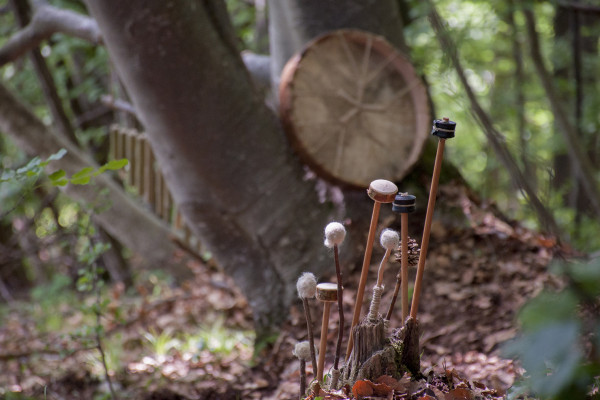
Close-up of the music station: playing sticks, shamanic drum and bamboo row chime.
Students:
Eliza Zimmermann, Emilia Bodenmüller, Juliana Lopes Sauaia
Teaching Team:
David Calas (Object–Spaces–Services)
Kris Krois (Communication–Interaction–Services)
Secil Ugur Yavuz (Design Research)
Marie Beuthel (Social Interaction Design)
Partner:
Sottobosco (Sofia Set)
Supporters & Stakeholders:
La Fonte (Elisabetta Monti)
La Foresta (Fabio Franz & Bianca Elzenbaumer)
Max Castlunger
Sottobosco families